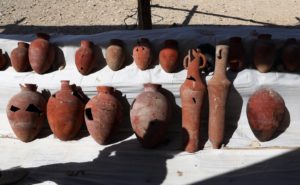São Paulo – Egypt announced that a mission under the Egyptian archeologist Zahi Hawass discovered a city in Luxor that was lost under the sands 3000 years ago. Dubbed the Lost Golden City, the discovery was announced last week. Also called “The Rise of Aten”, the city dates to the reign of Amenhotep III and continued to be used by Tutankhamun and Ay, local newspaper Al Ahram reported. Amenhotep III was a king of the 18th Egyptian dynasty. Luxor is in South Egypt, 500 kilometer from Cairo.

According to the archeologists, it was the largest urban settlement ever found and the second most important archeological discovery since the tomb of Tutankhamun in the 20s. “Many foreign missions searched for this city and never found it. We began our work searching for the mortuary temple of Tutankhamun because the temples of both Horemheb and Ay were found in this area,” Hawass told the Egyptian newspaper.
Founded by one of the greatest rulers of Egypt, king Amenhotep III, the ninth king of the 18th dynasty, who ruled Egypt from 1391 till 1353 B.C., this city was active during the great king’s co-regency with his son, the famous Amenhotep IV, aka Akhenaton. The Egyptian expedition was surprised to discover the largest city ever found in Egypt, which was also the largest administrative and industrial settlement in the era of the Egyptian empire on the western bank of Luxor.
“The city’s streets are flanked by houses; some of their walls are up to 3 meters high, we can reveal that the city extends to the west, all the way to the famous Deir El-Medina,” Hawass said.
The excavation area is sandwiched between Rameses III’s temple and Amenhotep III’s temple. The Egyptian mission started working in this area in search of Tutankhamun’s Mortuary Temple. The excavation started in September 2020, and within weeks, to the team’s great surprise, formations of mud bricks began to appear in all directions. What they unearthed was the site of a large city in good condition of preservation.
You may also enjoy reading:
- Zahi Hawass sees Egypt-themed samba
- Zahi Hawass hopes to announce major find soon
- Zahi Hawass to open Tutankhamun museum in Brazil
Many archaeological finds, such as rings, scarabs, colored pottery vessels, and mud bricks bearing seals of king Amenhotep III’s cartouche, confirmed the dating of the city.
After only seven months of excavation, several areas or neighborhoods have been uncovered. In the southern part, the mission found a bakery, a cooking and food preparation area, complete with ovens and storage pottery. From its size, one can state the kitchen was catering to a very large number of workers and employees.
The second area, which is still partly uncovered, is the administrative and residential district, with larger and well-arranged units. This area is fenced in by a zigzag wall, with only one access point leading to internal corridors and residential areas. The single entrance represents some sort of security, with the ability to control entry and exit to enclosed areas. Zigzag walls are one of the rare architectural elements in ancient Egyptian architecture, mainly used towards the end of the 18th dynasty.

The third area is a workshop. On one side, the production area for the mud bricks used to build temples and annexes. The bricks have seals bearing the cartouche of king Amenhotep III. On the other, many casting molds for the production of amulets and delicate decorative elements. This is further evidence of the extensive activity in the city to produce decorations for both temples and tombs.
All over the excavated areas, the mission found many tools used in some sort of industrial activity like spinning and weaving. Metal and glass-making slag has also been unearthed, but the main area of such activity has yet to be discovered.
Two unusual burials of a cow or bull were found inside one of the rooms. One of the most recent finds is a vessel containing two gallons of dried or boiled meat; it has a valuable inscription: Year 37, dressed meat for the third Heb Sed festival from the slaughterhouse of the stockyard of Kha, made by the butcher luwy. To the north of the settlement, a large cemetery was uncovered, the extent of which has yet to be determined. Work is underway and the mission expects to uncover untouched tombs filled with treasures.
Translated by Guilherme Miranda




